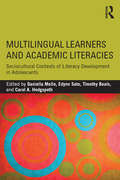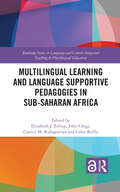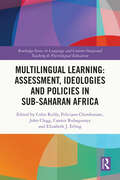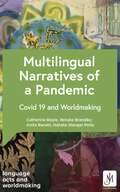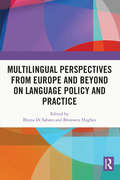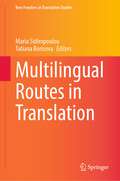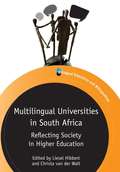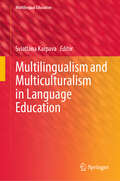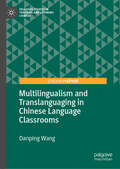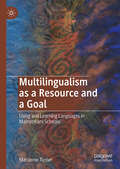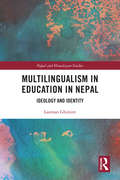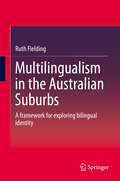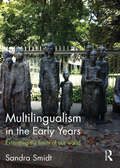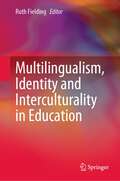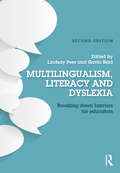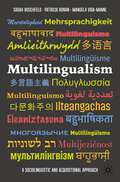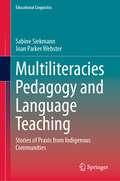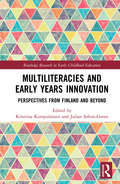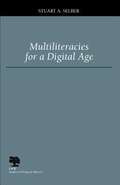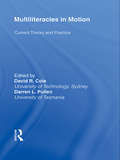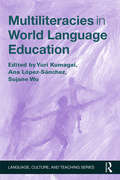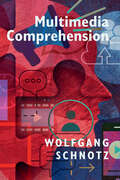- Table View
- List View
Multilingual Learners and Academic Literacies: Sociocultural Contexts of Literacy Development in Adolescents
by Daniella Molle Edynn Sato Timothy Boals Carol A. HedgspethShifting the discourse from a focus on academic language to the more dynamic but less researched construct of academic literacies, this volume addresses three key questions: • What constitutes academic literacy? • What does academic literacy development in adolescent multilingual students look like and how can this development be assessed? • What classroom contexts foster the development of academic literacies in multilingual adolescents? The contributing authors provide divergent definitions of academic literacies and use dissimilar theoretical and methodological approaches to study literacy development. Nevertheless, all chapters reflect a shared conceptual framework for examining academic literacies as situated, overlapping, meaning-making practices. This framework foregrounds students’ participation in valued disciplinary literacy practices. Emphasized in the new college and career readiness standards, the notion of disciplinary practices allows the contributing authors to bridge the language/content dichotomy, and take a more holistic as well as nuanced view of the demands that multilingual students face in general education classrooms. The volume also explores the implications of the emphasis on academic literacy practices for classroom instruction, research, and policy.
Multilingual Learning and Language Supportive Pedagogies in Sub-Saharan Africa (Routledge Series in Language and Content Integrated Teaching & Plurilingual Education)
by Elizabeth J. ErlingThis edited collection provides unprecedented insight into the emerging field of multilingual education in Sub-Saharan Africa (SSA). Multilingual education is claimed to have many benefits, amongst which are that it can improve both content and language learning, especially for learners who may have low ability in the medium of instruction and are consequently struggling to learn. The book represents a range of Sub-Saharan school contexts and describes how multilingual strategies have been developed and implemented within them to support the learning of content and language. It looks at multilingual learning from several points of view, including ‘translanguaging’, or the use of multiple languages – and especially African languages – for learning and language-supportive pedagogy, or the implementation of a distinct pedagogy to support learners working through the medium of a second language. The book puts forward strategies for creating materials, classroom environments and teacher education programmes which support the use of all of a student’s languages to improve language and content learning. The contexts which the book describes are challenging, including low school resourcing, poverty and low literacy in the home, and school policy which militates against the use of African languages in school. The volume also draws on multilingual education approaches which have been successfully carried out in higher resource countries and lend themselves to being adapted for use in SSA. It shows how multilingual learning can bring about transformation in education and provides inspiration for how these strategies might spread and be further developed to improve learning in schools in SSA and beyond.
Multilingual Learning: Assessment, Ideologies and Policies in Sub-Saharan Africa (Routledge Series in Language and Content Integrated Teaching & Plurilingual Education)
by Elizabeth J. Erling Feliciano Chimbutane John Clegg Colin Reilly Casmir RubagumyaThis edited volume provides the follow up to Erling et al.’s (2021) Multilingual Learning and Language Supportive Pedagogies in Sub-Saharan Africa. The strategies put forward in Volume 1 included multilingual pedagogies that allow students to draw on their full linguistic repertoires, translanguaging and other language supportive pedagogies. While there is great traction in the pedagogical strategies proposed in Volume 1, limited progress has been made in terms of multilingual education in SSA. Thus, the main focus of this follow-up volume is to explore the question of why former colonial languages and monolingual approaches continue to be used as the dominant languages of education, even when we have multilingual pedagogies and materials that could and do work and despite substantial evidence that learners have difficulties when taught in a language they do not understand. This book offers perspectives to answer this question through focusing on the internal and external pressures which impact the capacity for implementing multilingual strategies in educational contexts at regional, national, and community levels. Chapters provide insights into how to better understand and work within these contemporary constraints and challenge dominant monoglossic discourses which inhibit the implementation of multilingual education in SSA. The volume focuses on three main areas which have proven to be stumbling blocks to the effective implementation of multilingual education to date, namely: Assessment, Ideology and Policy. An insightful collection that will be of great interest to academics, researchers, and practitioners in the fields of language education, language-in-education policy and educational assessments in the wide range of multilingual contexts in Africa.
Multilingual Lexical Recognition in the Mental Lexicon of Third Language Users
by Weronika Szubko-SitarekThe monograph constitutes an attempt to demonstrate that trilinguals should be considered as learners and speakers in their own right as opposed to L2 learners with a view to enumerating consequences this would bring to third or additional language teaching. Its theoretical part offers an insight into the structure of the multilingual mental lexicon which is a product of the interplay of a whole array of cross-linguistic factors in the minds of multilingual speakers. The empirical part reports the findings of an empirical study which aimed to investigate connections which are formed between multiple languages in a multilingual mind. All the aspects, analyzed in the experiments are part of a broader question of how multilinguals make their lexical decisions and, more specifically, how they recognize words from different languages. The book closes with the discussion of the role of the obtained results for multilingual didactics as well as some possible areas for future research.
Multilingual Narratives of a Pandemic: Covid 19 and Worldmaking (Language Acts and Worldmaking)
by Various Professor Catherine BoyleWe narrate everything. We construct the world around us by telling its stories, shaping the language we use to describe what is happening to us; language that is used and adapted in the media in response to moments of crisis. This language in turn shapes how we see the world. This is what we call 'worldmaking'. When we look for solutions to problems, we so often start by telling stories to each other in our communities, stories that set a crisis in context, relate it to our historical experience, help us to understand it in the context of our local communities and contrast those stories to dominant narratives. In this way, language becomes a physical and material force in our world, through which we construct our personal, local, transnational and spiritual identities.'Worldmaking in the Time of COVID-19', the project that informs this book, was an early response to the experience of living through the COVID-19 pandemic - intended as a contribution to our collective understanding of the COVID-19 pandemic. Following comparison and analysis of over 1.1 million news articles from 117 countries in twelve different languages, this timely reflection follows the course of this investigation, with three main objectives: - to capture the languages of the early pandemic (January-April 2020); - to offer a transferable methodology for exploring world events in multiple languages; - and to share some of the key findings of researchers. Like all the volumes in the Language Acts and Worldmaking series, the overall aim is two-fold: to challenge widely-held views about language learning as a neutral instrument of globalisation and to innovate and transform language research, teaching and learning, together with Modern Languages as an academic discipline, by foregrounding its unique form of cognition and critical engagement. Specific aims are to:· propose new ways of bridging the gaps between those who teach and research languages and those who learn and use them in everyday contexts from the professional to the personal· put research into the hands of wider audiences· share a philosophy, policy and practice of language teaching and learning which turns research into action· provide the research, experience and data to enable informed debates on current issues and attitudes in language learning, teaching and research· share knowledge across and within all levels and experiences of language learning and teaching· showcase exciting new work that derives from different types of community activity and is of practical relevance to its audiences· disseminate new research in languages that engages with diverse communities of language practitioners.
Multilingual Narratives of a Pandemic: Covid 19 and Worldmaking (Language Acts and Worldmaking)
by Various Professor Catherine BoyleWe narrate everything. We construct the world around us by telling its stories, shaping the language we use to describe what is happening to us; language that is used and adapted in the media in response to moments of crisis. This language in turn shapes how we see the world. This is what we call 'worldmaking'. When we look for solutions to problems, we so often start by telling stories to each other in our communities, stories that set a crisis in context, relate it to our historical experience, help us to understand it in the context of our local communities and contrast those stories to dominant narratives. In this way, language becomes a physical and material force in our world, through which we construct our personal, local, transnational and spiritual identities.'Worldmaking in the Time of COVID-19', the project that informs this book, was an early response to the experience of living through the COVID-19 pandemic - intended as a contribution to our collective understanding of the COVID-19 pandemic. Following comparison and analysis of over 1.1 million news articles from 117 countries in twelve different languages, this timely reflection follows the course of this investigation, with three main objectives: - to capture the languages of the early pandemic (January-April 2020); - to offer a transferable methodology for exploring world events in multiple languages; - and to share some of the key findings of researchers. Like all the volumes in the Language Acts and Worldmaking series, the overall aim is two-fold: to challenge widely-held views about language learning as a neutral instrument of globalisation and to innovate and transform language research, teaching and learning, together with Modern Languages as an academic discipline, by foregrounding its unique form of cognition and critical engagement. Specific aims are to:· propose new ways of bridging the gaps between those who teach and research languages and those who learn and use them in everyday contexts from the professional to the personal· put research into the hands of wider audiences· share a philosophy, policy and practice of language teaching and learning which turns research into action· provide the research, experience and data to enable informed debates on current issues and attitudes in language learning, teaching and research· share knowledge across and within all levels and experiences of language learning and teaching· showcase exciting new work that derives from different types of community activity and is of practical relevance to its audiences· disseminate new research in languages that engages with diverse communities of language practitioners.
Multilingual Perspectives from Europe and Beyond on Language Policy and Practice (Routledge Research in Language Education)
by Bronwen Hughes Bruna Di SabatoThis edited volume offers an overarching yet detailed view of fast-changing language policy and practice in Europe and beyond. It provides a thorough investigation of different linguacultural scenarios, exploring how language policy has repercussions on research and initiatives in the field of language education. With contributions from a range of European settings as well as Turkey and the USA, the book discusses topical issues related to language learning and explores how these can shape our identities. Chapters present cutting-edge research on translanguaging, EMI, multilingualism and minority languages in Europe. The volume forecasts what future educational policies might look like, and questions how evaluating and rethinking educational practices can produce positive effects on language practices as well as language policies. The book has a wide-reaching international focus and will be an important resource for researchers, academics, language experts and postgraduate students in the fields of applied linguistics, language education and sociolinguistics.
Multilingual Routes in Translation (New Frontiers in Translation Studies)
by Tatiana Borisova Maria SidiropoulouThis book tackles the interface between translation and pragmatics. It comprises case studies in English, Greek, Russian and Chinese translation practice, which highlight the potential of translation to interact with pragmatics and reshape meaning making in a target language in various pragmatically relevant ways. Fiction and non-fiction genres merge to suggest a rich inventory of interlingual transfer instances which can broaden our perception of what may be shifting in translation transfer. Authors use an emic approach (in addition to an etic one) to confirm results which they often present graphically. The book has a didactic perspective in that it shows how pragmatic awareness can regulate translator behaviour and is also useful in foreign language teaching, because it shows how important implicit knowledge can be, in shaping the message in a foreign language.
Multilingual Universities in South Africa
by Liesel Hibbert Christa van der WaltFocusing on the use of African languages in higher education, this book showcases South African higher education practitioners' attempts to promote a multilingual ethos in their classes. It is a first-time overview of multilingual teaching and learning strategies that have been tried and tested in a number of higher education institutions in South Africa. Despite language-in-education policies that extol the virtues of multilingualism, practice remains oriented towards English-only learning and teaching. In the multilingual contexts of local campuses, this book shows how students and lecturers attempt to understand their multiple identities and use the available languages to create multilingual learning environments.
Multilingualism and Multiculturalism in Language Education (Multilingual Education #49)
by Sviatlana KarpavaThis volume focuses on multidisciplinary approaches to multilingualism, multiculturalism and language teaching and learning at (pre)primary, secondary and tertiary levels. It addresses both top-down and bottom-up perspectives on language education policies, teacher training and preparation. The book explores the needs and challenges related to education in multilingual classrooms, the relationship between parents and educators, and linguistic and cultural diversity in classrooms. It draws on the findings of research that has been conducted worldwide including in Cyprus, USA, UK, Scotland, Spain, France, Sri Lanka, Slovenia, Australia, New Zealand, Indonesia, Hong Kong, Sweden, Greece, and Italy. This book is ideal for students of (applied) linguistics, (socio)linguistics, psycholinguistics, language acquisition and education, as well as practitioners, teachers, parents, experts and researchers wishing to update their knowledge regarding multilingualism, multiculturalism, language learning, and teaching.
Multilingualism and Translanguaging in Chinese Language Classrooms (Palgrave Studies in Teaching and Learning Chinese)
by Danping WangThis book presents new research on Chinese as a Second Language (CSL) teaching from an ethnographic classroom study on classroom translanguaging practices that highlights the policy and pedagogical implications of adopting a creative and principled multilingual approach. Drawing on a case study from Hong Kong, it analyses naturally observed language patterns in CSL classrooms and the attitudes of students and teachers towards prescribed classroom language policies, and thereby demonstrates the importance of mixing Chinese, English and students’ home languages to achieve successful second language learning. It discusses the nature and guiding principles for classroom translanguaging research and provides research tools that will enable second language teachers to examine their own language practices. The author argues persuasively that second language teaching practices and policies must reflect the current reality of language use and the diverse learning needs of multilingual students. This book will appeal to teacher educators and researchers in fields such as second language acquisition, foreign language teaching and language policy.
Multilingualism as a Resource and a Goal: Using and Learning Languages in Mainstream Schools
by Marianne TurnerThis book explores multilingualism as a resource and goal at school in contexts of student diversity and institutional monolingualism. Combining translanguaging theory and sociocultural theory, the author proposes a framework for the learning and use of both foreign and heritage languages across the curriculum in mainstream schools. By clearly linking language practices to teaching and learning objectives, the book aims to support school leaders and practitioners make informed decisions about how best to promote multilingualism in their school, as well as to enhance the learning outcomes of bi/multilinguals. In addition to school leaders and practitioners, it will be of interest to students and academics in the fields of bilingual education and TESOL, as well as applied linguistics and language teaching more broadly.
Multilingualism in Education in Nepal: Ideology and Identity (Nepal and Himalayan Studies)
by Laxman GhimireThis book explores the development of multilingual policy in education in Nepal in sociopolitical and historical contexts and examines the frameworks of language use in schools. It investigates the dynamics and factors that influence the process of construction and appropriation of the policy of multilingualism in education. The book surveys the language situation in schools and discusses how it is impacted by local language positions, societal power relations, ideological and identity contestations, and the attitude, language behaviour and resistance of key actors. It highlights the role of pedagogy, linguistics and politics that govern the policy of multilingual education. The author assesses the prospects of a multilingual approach to learning via teacher preparation, curriculum and learning material development, coordination of actors and institutions, and resources available in schools. The book presents Nepal’s linguistic background while discussing how multilingualism in education recognises local languages to improve the quality of learning in classrooms in ethnolinguistic communities. Evaluating the use of local languages in classrooms, it explores monolingual, multilingual and language maintenance frameworks of multilingualism in education. This book will be of interest to teachers, students, and researchers of education and educational studies, linguistics, sociology of education, school education, language studies, sociolinguistics, language policy and planning, public administration, ethnolinguistics, and sociology of language. It will also be useful to educationists, policymakers, linguists, sociolinguists and those working in related areas.
Multilingualism in the Australian Suburbs
by Ruth FieldingThis book introduces a framework for examining bilingual identity and presents the cases of seven individual children from a study of young students' bilingual identities in an Australian primary school. The new Bilingual Identity Negotiation Framework brings together three elements that influence bilingual identity development - sociocultural connection, investment and interaction. The cases comprise individual stories about seven young, bilingual students and are complemented by some more general investigations of bilingual identity from a whole class of students at the school. The framework is explained and supported using the students' stories and offers readers a new concept for examining and thinking about bilingual identity. This book builds upon past and current theories of identity and bilingualism and expands on these to identify three interlinking elements within bilingual identity. The book highlights the need for greater dialogue between different sectors of research and education relating to languages and bilingualism. It adds to the increasing call for collaborative work from the different fields interested in language learning and teaching such as TESOL, bilingualism, and language education. Through the development of the framework and the students' stories in this study, this book shows how multilingual children in one school in Australia developed their identities in association with their home and school languages. This provides readers with a model for examining bilingual identity in their own contexts, or a theoretical construct to consider in their thinking on bilingualism, language and identity.
Multilingualism in the Early Years: Extending the limits of our world
by Sandra SmidtMultilingualism in the Early Years is a highly accessible text that examines the political, theoretical, ideological and practical issues involved in the education of children speaking two or more languages. Drawing on current research and thinking about the advantages and disadvantages of being multilingual, Smidt uses powerful case studies to reveal how language or languages are acquired. She explores language in terms of who shares it, its relationship to class, culture, power, identity and thinking, and its fascinating role as it moves from the personal to the public and political. More specifically the book studies: what it means to be bilingual through an analysis of the language histories submitted by a range of people; how language/s define people; a brief history of minority education in the UK; how practitioners and teachers can best support all young children as learners whilst they continue to use their first languages and remain part of and partners in their communities and cultures; being bilingual: an advantage or a disadvantage? the impact of multilingualism on children’s educational and life chances.? Multilingualism in the Early Years is a really useful text for practitioners working with multilingual children, as well as any student undertaking courses in early childhood education.
Multilingualism, Identity and Interculturality in Education
by Ruth FieldingThis book brings together research on multilingualism, identity and intercultural understanding from a range of locations across the globe to explore the intersection of these key ideas in education. It addresses the need to better understand how multilingual, identity, and intercultural approaches intersect for multilingual learners in complex and varied settings. Through global examples, it explores how identities and multilingualism are situated within, and surrounding intercultural experiences. This book examines the different theoretical interpretations as encountered and used in different contexts. By doing so, it helps readers better understand how teachers approach multilingualism and diversity in a range of contexts.
Multilingualism, Literacy and Dyslexia: Breaking down barriers for educators
by Gavin Reid Lindsay PeerThis fully revised new edition provides advice on the identification, assessment and support of bilingual learners and assists practitioners in identifying the difference between literacy difficulties due to bilingualism or multilingualism and dyslexia. An essential text for staff development, it includes innovative approaches in technology and teaching programmes beneficial to multilingual learners and advice on learning additional languages. With contributions from experts from across the globe, this book will provide guidance on key themes, including: the assessment of multilingual learners the impact of dyslexia on bilingualism the literacy challenges facing learners from Indigenous cultures the role of the SENCO in identifying children with English as an additional language and Dyslexia the emotional needs of learners with bi/multilingualism and Dyslexia This book will provide guidance to anyone involved in literacy development and language learning. With the increase in international schools around the globe and the ever growing desire for parents to ensure that their children become proficient in English, this book will appeal to teachers, teaching assistants, specialists, and all other practitioners who work with bi/multilingual children.
Multilingualism: A Sociolinguistic and Acquisitional Approach
by Sarah Buschfeld Manuela Vida-Mannl Patricia RonanThis textbook takes a broad perspective on multilingualism, using a sociolinguistics and acquisition-informed approach that treats multilingualism not solely as the mastery of two or more well-defined language systems, but rather as a continuum of linguistic repertoires and resources to be used in different settings and combinations. The authors introduce traditional aspects of multilingualism - including historical dimensions, societal and individual multilingualism, aspects of identities, ideologies, education, and language policies - before going on to examine newer manifestations such as multilingualism in migrant and refugee contexts, in new media, pop music and linguistic landscaping, as well as the notion of grassroots multilingualism. This textbook will be an ideal resource for postgraduate students of linguistics and multilingualism, as well as advanced undergraduate students who are looking for a nuanced and holistic approach to the topic.
Multiliteracies Pedagogy and Language Teaching: Stories of Praxis from Indigenous Communities (Educational Linguistics #60)
by Sabine Siekmann Joan Parker WebsterThis volume offers an approach to language and literacy instruction that brings together theoretical concepts of multiliteracies and second language acquisition. This approach is illustrated through examples of innovative teacher-generated action research conducted in Indigenous and English, dual language and immersion classrooms, all situated in the context of language and cultural maintenance and revitalization. These examples of praxis help to bridge the gap between theory and practice in Indigenous language and literacy teaching. The volume draws on critical theories of praxis and the concept of multiliteracies and multimodalities, with specific attention to the design cycle as a way to conceptualize and engage in praxis through research and pedagogy. The authors trace teacher trajectories relating to (language) teaching and their positionalities in language revitalization and maintenance efforts by using a participatory teacher action research approach. The final chapter brings together Indigenous and western onto-epistemological and methodological perspectives in a conversation among two western and an Indigenous scholar, who have been working together with the teacher-researchers whose stories are presented in this volume. This volume is of interest to scholars, graduate students, educational practitioners and educational leaders interested in multiliteracies, multimodalities, teacher action research, and Indigenous pedagogies.
Multiliteracies and Early Years Innovation: Perspectives from Finland and Beyond (Routledge Research in Early Childhood Education)
by Julian Sefton-Green Kristiina KumpulainenMultiliteracies and Early Years Innovation: Perspectives from Finland and Beyond brings together internationally renowned scholars to investigate and reflect upon the significance of introducing multiliteracies in the education of children (0–8 years old) and the challenge of enhancing professional development opportunities of early years practitioners. The book brings together curriculum innovation and reform and the changing media ecology of young children's learning lives in a single volume. It provides insights into Finnish early years education in terms of policy, practice, and research with a specific focus on the enhancement of children’s multiliteracies. Case studies from around the world explore co-developing practices between researchers and teachers, the development of communities and the ways in which different classroom interventions draw on new kinds of teacher knowledge. This book will appeal to academics, researchers, and postgraduate students with an interest in early years education, literacy education, the sociology of digital culture, school reform, teacher education, and comparative education.
Multiliteracies for a Digital Age
by Stuart A. SelberThis is a guide for composition teachers to develop effective, full-scale computer literacy programs that are also professionally responsible by emphasizing different kinds of literacies and proposing methods for helping students move among them in strategic ways.
Multiliteracies in Motion: Current Theory and Practice
by David R. Cole Darren Lee PullenThe realities of new technological and social conditions since the 1990s demand a new approach to literacy teaching. Looking onward from the original statement of aims of the multiliteracies movement in 1996, this volume brings together top-quality scholarship and research that has embraced the notion and features new contributions by many of the originators of this approach to literacy. Drawing on large research projects and empirical evidence, the authors explore practical and educational issues that relate to multiliteracies, such as assessment, pedagogy and curriculum. The viewpoint taken is that multiliteracies is a complementary socio-cultural approach to the new literacies that includes pedagogy and learning. The differences are addressed from a multiliteracies perspective – one that does not discount or undermine the new literacies, but shows new ways in which they are complementary. Computers and the internet are transforming the way we work and communicate and the very notion of literacy itself. This volume offers frontline information and a vital update for those wishing to understand the evolution of multiliteracies and the current state of literacy theory in relation to it.
Multiliteracies in World Language Education (Language, Culture, and Teaching Series)
by Yuri Kumagai Ana López-Sánchez Sujane WuPutting a multiliteracies framework at the center of the world language curriculum, this volume brings together college-level curricular innovations and classroom projects that address differences in meaning and worldviews expressed in learners’ primary and target languages. Offering a rich understanding of languages, genres, and modalities as socioculturally situated semiotic systems, it advocates an effective pedagogy for developing learners’ abilities to operate between languages. Chapters showcase curricula that draw on a multiliteracies framework and present various classroom projects that develop aspects of multiliteracies for language learners. A discussion of the theoretical background and historical development of the pedagogy of multiliteracies and its relevance to the field of world language education positions this book within the broader literature on foreign language education. As developments in globalization, accountability, and austerity challenge contemporary academia and the current structure of world language programs, this book shows how the implementation of a multiliteracies-based approach brings coherence to language programs, and how the framework can help to accomplish the goals of higher education in general and of language education in particular.
Multimedia Comprehension
by Wolfgang SchnotzMultimedia messages use combinations of texts, pictures, maps, and graphs as tools for communication. This book provides a synthesis of theory and research about how people comprehend multimedia. It adopts the perspectives of cognitive psychology, semiotics, anthropology, linguistics, education, and art. Its central idea is that information displays can be categorized into two different but complementary forms of representations, which service different purposes in human cognition and communication. Specific interaction between these representations enhances comprehension, thinking, and problem solving, as illustrated by numerous examples. Multimedia Comprehension is written for a broad audience with no special prior knowledge. It is of interest to everyone trying to understand how people comprehend multimedia, from scholars and students in psychology, communication, and education, to web- and interface-designers and instructors.
Multimedia Technology and Enhanced Learning: 4th EAI International Conference, ICMTEL 2022, Virtual Event, April 15-16, 2022, Proceedings (Lecture Notes of the Institute for Computer Sciences, Social Informatics and Telecommunications Engineering #446)
by Shui-Hua Wang Yu-Dong ZhangThis proceedings, ICMTEL 2022, constitutes the refereed proceedings of the 4th International Conference on Multimedia Technology and Enhanced Learning, ICMTEL 2022, held in April 2022. Due to the COVID-19 pandemic the conference was held virtually.The 59 revised full papers have been selected from 188 submissions. They were organized in topical sections as follows: internet of things and communication; education and enterprise; machine learning; big data and signal processing; workshop of data fusion for positioning and navigation; and workshop of intelligent systems and control.
